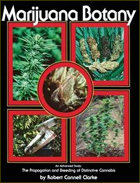
by Robert Connell Clarke
Curing Floral Clusters
Harvesting, drying, curing, and storage of Cannabis floral clusters to preserve and enhance appearance, taste, and psychoactivity is often discussed among cultivators. More floral clusters are ruined by poor handling after harvest than by any other single cause. When the plant is harvested, the production of fine floral clusters for smoking begins. Cannabis floral clusters are harvested by two basic methods: either individually, by cutting them from the stalks and carefully packaging them in shallow boxes or trays, or all simultaneously by uprooting or cutting off the entire plant. In instances where the floral clusters mature sequentially, individual harvest is used because the entire plant is not ripe at any given time. Removing individual clusters also makes drying easier and quicker because the stalks are divided into shorter pieces. Floral clusters will dry much more slowly if the plant is dried whole. This means that all of the water in the plant must pass through the stomata on the surface of the leaves and calyxes instead of through cut stem ends. The stomata close soon after harvest and drying is slowed since little water vapor escapes.
Boiling attached Cannabis roots after harvesting whole plants, but before drying, is an interesting technique. Originally it was thought by cultivators that boiling the roots would force resins to the floral clusters. In actuality, there are very few resins within the vascular system of the plant and most of the resins have been secreted in the heads of glandular trichomes. Once resins are secreted they are no longer water-soluble and are not part of the vascular system. As a result, neither boiling nor any other process will move resins and cannabinoids around the plant. However, boiling the roots does lengthen the drying time of the whole plant. Boiling the roots shocks the stomata of the leaves and forces them to close immediately; less water vapor is allowed to escape and the floral clusters dry more slowly. If the leaves are left intact when drying, the water evaporates through the leaves instead of through the flowers.
Whole plants, limbs, and floral clusters are usually hung upside down or laid out on screen trays to dry. Many cultivators believe that hanging floral clusters upside-down to dry makes the resins flow by gravity to the limb tips. As with boiling roots, little if any transport of cannabinoids and resins through the vascular system occurs after the plant is harvested. Inverted drying does cause the leaves to hang next to the floral clusters as they dry, and the resins are protected from rubbing off during handling. Floral clusters also appear more attractive and larger if they are hung to dry. When laid out flat to dry, floral clusters usually develop a flattened, slightly pressed profile, and the leaves do not dry around the floral clusters and protect them. Also, the floral clusters are usually turned to prevent spoilage; this requires extra handling. It is easy to bruise the clusters during handling, and upon drying, bruised tissue will turn dark green or brown. Resins are very fragile and fall from the outside of the calyx if shaken. The less handling the floral clusters receive the better they look, taste and smoke. Floral clusters, including large leaves and stems, usually dry to about 25% of their original fresh weight. When dry enough to store without the threat of mold, the central stem of the floral cluster will snap briskly when bent. Usually about 10% water remains in dry, stored Cannabis floral clusters prepared for smoking. If some water content is not maintained, the resins will lose potency and the clusters will disintegrate into a useless powder exposed to decomposition by the atmosphere.
As floral clusters dry, and even after they are sealed and packaged, they continue to cure. Curing removes the unpleasant green taste and allows the resins and cannabinoids to finish ripening. Drying is merely the removal of water from the floral clusters so they will be dry enough to burn. Curing takes this process one step farther to produce tasty and psychoactive marijuana. If drying occurs too rapidly, the green taste will be sealed into the tissues and may remain there indefinitely. A floral cluster is not dead after harvest any more than an apple is. Certain metabolic activities take place for some time, much like the ripening and eventual spoiling of an apple after it is picked. During this period, cannabinoid acids decarboxylate into the psychoactive cannabinoids and terpenes isomerize to create new polyterpenes with tastes and aromas different from fresh floral clusters. It is suspected that cannabinoid biosynthesis may also continue for a short time after harvest. Taste and aroma also improve as chlorophylls and other pigments begin to break down. When floral clusters are dried slowly they are kept at a humidity very near that of the inside of the stomata. Alternatively, sealing and opening bags or jars or clusters is a procedure that keeps the humidity high within the container and allows the periodic venting of gases given off during curing. It also exposes the clusters to fresh air needed for proper curing. If the container is airtight and not vented, then rot from anaerobic bacteria and mold is often seen. Paper boxes breathe air but also retain moisture and are often used for curing Cannabis. Dry floral clusters are usually trimmed of outer leaves just prior to smoking. This is called manicuring. The leaves act as a wrapper to protect the delicate floral clusters. If manicured before drying, a significant increase in the rate of THC breakdown occurs.

